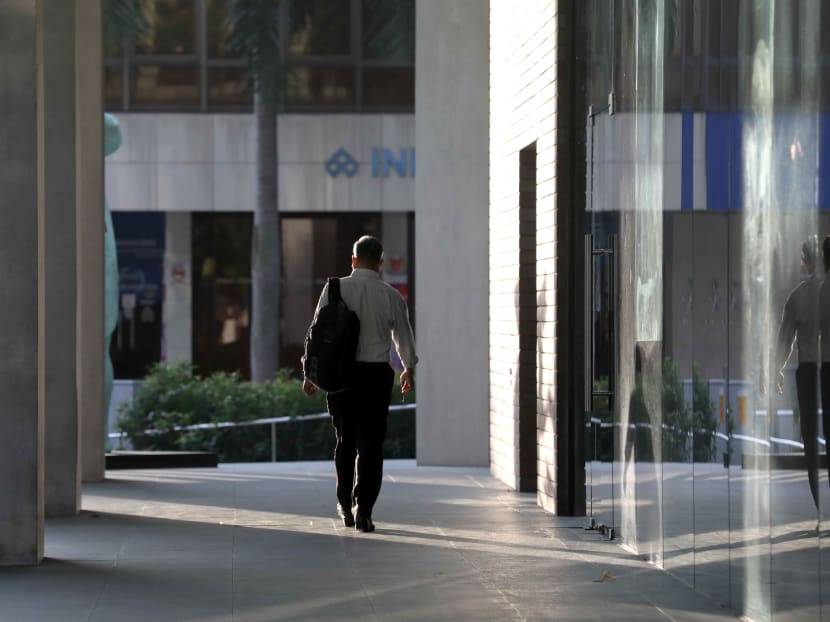The Big Read in short: Dealing with toxic workplaces
Each week, TODAY's long-running Big Read series delves into the trends and issues that matter. This week, we look at the issue of toxic workplaces which is in the spotlight after several well-known companies here were recently accused of having such a work environment. This is a shortened version of the full feature.

While toxic workplaces have existed all over the world for time immemorial, the issue is in the spotlight after several well-known companies in Singapore were in recent years accused of having such a work environment.
Each week, TODAY's long-running Big Read series delves into the trends and issues that matter. This week, we look at the issue of toxic workplaces which is in the spotlight after several well-known companies here were recently accused of having such a work environment. This is a shortened version of the full feature, which can be found here.
- While toxic workplaces have existed all over the world for time immemorial, the issue is in the spotlight after several well-known companies here were recently accused of having such a work environment
- Accounts of toxic offices are coming to the fore amid the proliferation of social media as well as online platforms which allow unhappy employees to air their grievances anonymously
- While employees’ experiences can be subjective, there are several signs to watch for in identifying a toxic workplace culture, said experts
- The emphasis on short-term success, particularly in start-ups, can inadvertently breed toxic behaviour in company leaders
- Some self-confessed toxic managers said they changed their ways after they were made aware of their harmful behaviour but ultimately, an employee needs to know when to walk away
SINGAPORE — John, a 26-year-old educator with a well-known enrichment centre here, works for a boss who is highly educated and well regarded by his peers and clients alike for his expertise.
But within the company, the boss — a high achiever by any standards with a glittering resume most can only dream of — is one who believes in rule by terror.
Before anyone could get a grip of what is going on, the boss would from time to time bombard staff with up to over a hundred text messages at one go in the company’s WhatsApp chat group, usually targeted at one employee.
Derogatory, expletive-laden messages, typed entirely in caps — which John showed to TODAY — are often sent late into the night or during meal times, in rants that would, at times, exceed an hour. They included phrases such as “human trash”, “your mother should have had an abortion” and “you deserve to die”.
Although John (not his real name) has so far not been the target of the boss’ rage, he said witnessing these frequent and intense tirades are enough to fill him with dread whenever the notification chime of new messages go off on his mobile phone.
“My work day could be going well, but all it takes is one message to evoke fear and cause a total mood swing, and many of my colleagues feel this way too,” he said.
The issue of toxic workplaces is in the spotlight after several well-known companies here, including Razer, Ubisoft Singapore, BooksActually and Night Owl Cinematics, were accused in recent years of having such a work environment.
THE WILD, WILD WEST
In recent years, accounts of toxic offices are coming to the fore amid the proliferation of social media as well as online platforms — such as Glassdoor and Tellonym — which allow unhappy employees to air their grievances anonymously.
In interviews conducted this week, more than 10 individuals spoke about how their mental health suffered due to highly toxic work environments, and also their disappointing experiences in seeking redress and accountability from people at the top.
They included employees of public sector organisations, start-ups and multinational corporations (MNCs). Some of these workplaces have highly developed human resource (HR) structures to handle such complaints, yet the rank-and-file do not have enough trust in these as the best avenues to seek help.
In the minds of some disheartened employees, their workplaces have become something of a “Wild Wild West”, where bullies and harassers roam freely and their victims are unable to tear down the power structures that foster a toxic working environment in the first place.
Contributing to their sense of helplessness is the fear of reprisal against victims who speak up, or even whistleblowers who are not the victims.
As a result, most cases go unreported as victims simply resign quietly from their jobs.
Ms Joanna Ong-Ash, 52, a former head of marketing and brand management at a local bank, is one of those who decided to do just that.
She had a boss who made her life “living hell” with incessant bullying and verbal abuse. He once even insulted her publicly using a Hokkien sexual slur.
When she finally plucked up the courage to report her problem to the bank’s HR department, she got brushed off with the remark: “He is just like that la, Jo, what can we do?”
Shocked, Ms Ong-Ash escalated the matter to her boss’ boss, only to hear the latter counter-propose for her to stay on to help him “find a silver bullet to get rid of” the man who had been terrorising her.
Initially pleased with the response, Ms Ong-Ash recalled her husband warning her later that she was venturing into a “danger zone” and would be made use of as a scapegoat.
Feeling utterly hopeless, she found herself contemplating taking her own life before she managed to snap out of it when she thought about her family.
Her experience with office toxicity happened several years ago, but when Ms Ong-Ash — who is now the director of her own firm Bravery Communications — shared her struggles on LinkedIn earlier this week, she received a number of direct messages from current employees of the same bank who said nothing much had changed.

For a 30-year-old HR manager, who wanted to be known only as Sarah, her former boss at a public sector organisation constantly undermined her abilities, once openly criticising her as an “incompetent” worker before other directors at a meeting.
When the then-communications executive tried to find out how she could lodge a formal complaint against the superior, a HR manager told her over the phone that “employee grievance” could only be made out if there was physical violence involved.
“(The HR manager’s) attitude towards this is like, ‘Don’t make HR life difficult. If you can, just try to tolerate it’. It is like telling you …if you are not happy, find another job,” Sarah said.
When she left the organisation, her exit interview took just five minutes as she sensed that the HR manager was not truly interested in acting upon what she would have to say.
SIGNS OF A TOXIC WORKPLACE
How can an employee tell whether a toxic work culture indeed exists in his or her organisation, as opposed to acts of a few rogue colleagues?
Professor Mak Yuen Teen, who teaches corporate governance at the National University of Singapore (NUS) Business School, said a toxic work culture exists in an organisation when any of these indicators is present:
Favouritism: Certain employees receive special treatment and are not held to rules that apply to everyone else, and given opportunities not because of their abilities.
Fear and harassment: Bullying behaviour and harassment in various forms are tolerated. Employees constantly fear being rebuked or fired. Communication is one-way and top down and there is no healthy debate.
Bad behaviour: Employees compete rather than collaborate and engage in cutthroat behaviour to get ahead. There is no courtesy and respect but malice and negativity.
Lack of development: Management does not see the value of training and developing employees.
Working in silos: There is no information sharing to help employees do their jobs. The organisation is very compartmentalised and one department does not know what the others are doing.
Lack of accountability: When there are transgressions, they are ignored. There are no consequences for rule-breaking and in fact, rule breakers may be rewarded.
OVERNIGHT SUCCESS, START-UP MODEL MAY BREED TOXIC BEHAVIOUR
Prof Mak added that such toxic culture is allowed to fester more than ever today due to the maddening pace at which the start-up model is being used to conduct business.
It used to be the case that companies sought to cultivate and retain good and loyal employees over time, as businesses were predominantly “built over a long time and entrepreneurs rarely got rich overnight”, he noted.
But the runway between starting a business and monetising it through someone buying the business or proceeding to the initial public offering stage is much shorter these days.
“Unfortunately, those who invest in start-ups at early stages often don’t take a long-term view. Private equity and venture capital investors are just looking at maximising valuations in preparation for their exit. So they may not be concerned about how employees are treated,” he said.
Prof Mak stressed that toxic work cultures always start from the top – often because of someone who has power but little accountability, such as the founder in a start-up, and is seen as an “untouchable” figure.
Professor Lawrence Loh, who is the director of the Centre for Governance and Sustainability at the NUS Business School, said toxicity occurs in every social group, but it is extremely sensitive in the workplace due to an asymmetry of power.
“One person has the power to hire and fire... This is where we have to take the problem by the horns and try to address it,” he said.
WHAT FIRMS NEED TO DO
But this power balance in the workplace is also shifting, with a growing number of employees seeking redress by going straight to social media.
Prof Loh also pointed to a new trend of firms going beyond financial reporting to cover “culture reporting”.
He said: “Companies had been managing external stakeholders. Now it is time to ‘come back home’ and examine what is on the inside.”
Agreeing, Prof Mak said that it is time to put more emphasis on HR functions in all organisations, not just in start-ups. “Sadly, many organisations, including public companies don’t pay enough attention to their human capital or people,” he said.
The lack of attention can be seen from the fact that the HR profession in Singapore is not as developed as it is in more advanced economies, said Prof Mak.
Boards also rarely appoint directors with human capital experience, he noted. “They think someone who has been a CEO would know HR and this is often not the case,” he added.
Dr Tan Hwee Hoon, also an associate professor in the same field at SMU, noted that in the area of fairness, firms often emphasise outcome fairness (pay and bonuses) but overlook procedural fairness (having avenues for redress and ensuring that the criteria for decision are made clear) and interpersonal fairness (treating folks with dignity).
Mr Alvin Goh, an executive director at the Singapore Human Resources Institute (SHRI), urged HR personnel to be the voice of employees and have “the moral courage to call out unfair workplace practices and abuses”.
In progressive organisations, HR should become a “strategic asset that assists business leaders to create an environment to bring the best out of its talents”, he said.
Apart from developing a whistleblowing policy, Mr Goh said companies can set up an “all ranks” committee that can independently investigate issues on workplace harassment.
WORKPLACE DISCRIMINATION LAWS A STEP FORWARD, BUT MORE CAN BE DONE
In August, Prime Minister Lee Hsien Loong announced that laws will be enacted to expand the range of actions that authorities can take against companies that discriminate against employees based on nationality, age, race, gender and disability.
Experts said that this is a step forward given that Singapore is a country with some of the weakest protection for employees.
Still, a lot more can be done.
“For one thing, it’s hard for employees to seek redress for unjust dismissals,” Prof Mak said. “Even if you sue and win, the legal costs will kill you and you won’t get punitive damages. That’s generally not the case in other developed markets. We should have something similar to a small claims tribunal or other dispute resolution mechanism for employees to go to.”
Indeed, Ms Ong-Ash once had a lawyer persuade her to drop her case of unfair dismissal, with the lawyer advising her to “just take the package and be happy”.
Still, there are existing laws to protect workers who feel harassed in toxic workplaces.
The Protection from Harassment Act (Poha), for instance, prohibits intentionally causing harassment, alarm or distress through threatening, abusive or insulting words or behaviour or through doxxing, said SMU Assistant Professor of Law Benjamin Joshua Ong.
Poha also covers “stalking”, which takes into account a course of conduct, or a series of acts, that collectively cause harassment, alarm or distress, even if each individual act may not by itself amount to wrongdoing.
SMU law lecturer Eugene Tan said a significant barrier to any law being effective in dealing with internal company affairs is the asymmetry of power within most organisations.
Even with Poha, it may not be “straightforward” to prove a case of harassment at work, he said.
As such, Singapore employment watchdog Tripartite Alliance for Fair and Progressive Employment Practices (Tafep) cannot remain a “paper tiger” that lacks enforcement teeth, said Assoc Prof Tan.
In response to TODAY’s queries, a Tafep spokesman said that it works with the Ministry of Manpower to take enforcement action against employers who fail to provide a safe environment or refuse to improve their grievance handling process after a complaint is made out.
But so far, employers engaged by Tafep have been cooperative and have heeded its advice, he said. Between 2019 and 2020, Tafep handled around 80 cases of workplace harassment, with about four in 10 involving harassers who were the victims’ supervisors or superiors.

SELF-CONFESSED TOXIC MANAGERS WHO CHANGED THEIR WAYS
For people managers themselves, helping to create a less toxic workplace is not always straightforward, with none of the three interviewed by TODAY getting it right the first time round.
Farah (not her real name), a 39-year-old corporate services manager, said it took some reprimanding from a HR director at her previous company three years ago to get her to reflect on her approach to people management.
This came after Farah screamed at one of her subordinates: “What the f*** have you done?”
The firm had a zero-tolerance policy on the use of vulgarities, she later learnt. “It made me realise that what I took from my previous companies (including a law firm where cursing and being heavy-handed were very much normalised) were toxic,” she said. “If I weren't being called out or reprimanded for it, then I think I'd still continue, thinking it's okay to behave that way.”
Mr Lim Hong Zhuang, CEO of blockchain start-up ShuttleOne, recognised that it was his fault for allowing a toxic work culture to fester at the previous company that he ran — an agricultural firm with about 200 workers — by simply accepting many demands of workers whom he deemed to be good.
He had thought he could “play favourites” with his better performing employees, and had also formed an “inner circle” with some of them. But he has since realised that it is a “terrible way” to manage people.
At his new start-up, Mr Lim encourages employees to be “brutal” with work quality but he is firm about not letting anybody engage in personal mudslinging.
He has already sacked a worker for launching a character attack on a colleague.
As for employees themselves, they must know when to walk away from toxicity, said Ms Ong-Ash.
She suggested that they ask themselves these questions: Am I empowered enough to add value to the job currently? Am I treated with decent human respect? Are the company’s values authentically aligned with mine and are leaders walking the talk on these values?
If most of the answers are "no", then perhaps it may be time to seek out greener pastures, or in this case a happier environment, she said.








